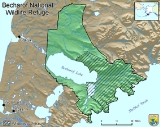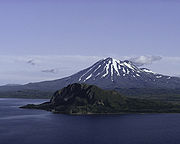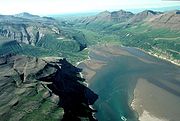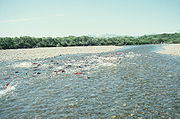
Becharof National Wildlife Refuge
Encyclopedia
Becharof National Wildlife Refuge is a National Wildlife Refuge
in the Aleutian Range
of the Alaska Peninsula
of southwestern Alaska
. Becharof National Wildlife Refuge, which covers an area of 1200000 acres (4,856.2 km²), was established in 1980 to conserve major brown bear
s, salmon
, migratory birds, caribou, marine birds, and mammals and to comply with treaty obligations. It lies primarily in the east-central part of Lake and Peninsula Borough
, but extends eastward into the mainland portion of Kodiak Island Borough
. The refuge is administered from offices in King Salmon
.
created Becharof National Monument by presidential proclamation on December 1, 1978. The refuge was established on December 2, 1980 by the Alaska National Interest Land Conservation Act (ANILCA). In 1983, the Fish and Wildlife Service undertook the responsibility to manage the Becharof Refuge, along with the Ugashik and Chignik units of the Alaska Peninsula National Wildlife Refuge
.
 In 1989 the park areas was heavily affected by the Exxon Valdez Oil Spill
In 1989 the park areas was heavily affected by the Exxon Valdez Oil Spill
which devastated the Alaska Peninsula. Puale Bay was the most heavily oiled bay outside of Prince William Sound
.
In an effort to determine species presence, distribution, habitat use, and migratory patterns, extensive landbird studies were conducted from 1995 through 1998 at various locations around Becharof Lake. Biologists continued the monitoring work in the park 2001 through 2003 using the same methods, paying notable attention to seabird activity, along with caribou and moose
populations. The refuge is affiliated with the Alaska Fish and Wildlife Cooperative Research Unit at the University of Alaska Fairbanks
to conduct research into the drainage basin east of the Ugashik Lakes on the Alaska Peninsula to monitor moose activity.
 The Becharof National Wildlife Refuge covers an area of 1200000 acres (4,856.2 km²). It lies on a mountainous coastline containing the Ugashik-Peulik
The Becharof National Wildlife Refuge covers an area of 1200000 acres (4,856.2 km²). It lies on a mountainous coastline containing the Ugashik-Peulik
volcano and steep cliffs and the park contains a range of geographical features from mountains, broad valleys and fjord
s, to tundra
and glacially formed lakes. Within the park lies the extensive Becharof Lake
which at 300000 acres (1,214.1 km²), 35 miles (56.3 km) long, 15 miles (24.1 km) wide and 600 feet (182.9 m) deep at deepest, it is second largest lake in Alaska and the largest in the entire National Wildlife Refuge System. The lake is fed by a number of rivers and streams, and contains some of the largest salmon
populations in the world. The lake has the world's second largest run of sockeye salmon
and estimates reveal that Becharof Lake and its tributaries provide the Bristol Bay fishery alone with six million adult salmon per year. Wildlife is abundant in the park and the high levels of salmon are enough to feed the largest concentrations of brown bear
s in Alaska. Moose
, caribou, fox
, wolverine
, otter
and beaver
are also found as are seal
s, sea lion
s, sea otter
s and whale
s and various seabirds such as eagle
s found along the shore.
 The Naknek River
The Naknek River
basin is one of the important wildlife habitats of the park. The river provides habitat for thousands of ducks, geese and swans that will later populate breeding lakes and ponds on the Alaska Peninsula and the area is closely monitored by biologists and ornithologists. The area contains notable populations of common merganser
, common goldeneye
, American green-winged teal, Canada goose
, greater scaup
, tundra swan, greater white-fronted goose, mallard
, northern pintail
, American and Eurasian wigeon
, northern shoveler
, red-breasted merganser
, black scoter
, and long-tailed duck
. From mid March through to mid May, refuge biologists monitor waterfowl from established points that extend from the mouth of Naknek Lake
to Kvichak Bay
in Naknek and register the waterfowl by species approximately four times a week. During winter populations of red-breasted merganser, common goldeneye, bald eagle, willow ptarmigan, glaucous-winged gull, gray jay
, black-billed magpie
, common raven
, chickadee
, northern shrike, and the common redpoll
amongst other birds can be spotted in the park.
National Wildlife Refuge
National Wildlife Refuge is a designation for certain protected areas of the United States managed by the United States Fish and Wildlife Service. The National Wildlife Refuge System is the world's premiere system of public lands and waters set aside to conserve America's fish, wildlife and plants...
in the Aleutian Range
Aleutian Range
The Aleutian Range is a major mountain range of southwest Alaska, extending from Chakachamna Lake to Unimak Island, at the tip of the Alaska Peninsula. It includes all of the mountains of the Peninsula. It is especially notable for its large number of active volcanoes, which are also part of the...
of the Alaska Peninsula
Alaska Peninsula
The Alaska Peninsula is a peninsula extending about to the southwest from the mainland of Alaska and ending in the Aleutian Islands. The peninsula separates the Pacific Ocean from Bristol Bay, an arm of the Bering Sea....
of southwestern Alaska
Alaska
Alaska is the largest state in the United States by area. It is situated in the northwest extremity of the North American continent, with Canada to the east, the Arctic Ocean to the north, and the Pacific Ocean to the west and south, with Russia further west across the Bering Strait...
. Becharof National Wildlife Refuge, which covers an area of 1200000 acres (4,856.2 km²), was established in 1980 to conserve major brown bear
Brown Bear
The brown bear is a large bear distributed across much of northern Eurasia and North America. It can weigh from and its largest subspecies, the Kodiak Bear, rivals the polar bear as the largest member of the bear family and as the largest land-based predator.There are several recognized...
s, salmon
Salmon
Salmon is the common name for several species of fish in the family Salmonidae. Several other fish in the same family are called trout; the difference is often said to be that salmon migrate and trout are resident, but this distinction does not strictly hold true...
, migratory birds, caribou, marine birds, and mammals and to comply with treaty obligations. It lies primarily in the east-central part of Lake and Peninsula Borough
Lake and Peninsula Borough, Alaska
-National protected areas:* Alagnak Wild River* Alaska Maritime National Wildlife Refuge ** Sutwik Island* Alaska Peninsula National Wildlife Refuge * Aniakchak National Monument and Preserve...
, but extends eastward into the mainland portion of Kodiak Island Borough
Kodiak Island Borough, Alaska
-National protected areas:* Alaska Maritime National Wildlife Refuge ** Barren Islands** Semidi Wilderness*** Semidi Islands** Trinity Islands*** Sitkinak Island*** Tugidak Island...
. The refuge is administered from offices in King Salmon
King Salmon, Alaska
King Salmon is a census-designated place in Bristol Bay Borough in the U.S. state of Alaska. As of the 2000 census the population was 442...
.
History
Jimmy CarterJimmy Carter
James Earl "Jimmy" Carter, Jr. is an American politician who served as the 39th President of the United States and was the recipient of the 2002 Nobel Peace Prize, the only U.S. President to have received the Prize after leaving office...
created Becharof National Monument by presidential proclamation on December 1, 1978. The refuge was established on December 2, 1980 by the Alaska National Interest Land Conservation Act (ANILCA). In 1983, the Fish and Wildlife Service undertook the responsibility to manage the Becharof Refuge, along with the Ugashik and Chignik units of the Alaska Peninsula National Wildlife Refuge
Alaska Peninsula National Wildlife Refuge
The Alaska Peninsula National Wildlife Refuge is a United States National Wildlife Refuge in southwestern Alaska whose use is regulated as an ecological-protection measure. It stretches along the southern coast of the Alaska Peninsula, between the Becharof National Wildlife Refuge on its east and...
.

Exxon Valdez oil spill
The Exxon Valdez oil spill occurred in Prince William Sound, Alaska, on March 24, 1989, when the Exxon Valdez, an oil tanker bound for Long Beach, California, struck Prince William Sound's Bligh Reef and spilled of crude oil. It is considered to be one of the most devastating human-caused...
which devastated the Alaska Peninsula. Puale Bay was the most heavily oiled bay outside of Prince William Sound
Prince William Sound
Prince William Sound is a sound off the Gulf of Alaska on the south coast of the U.S. state of Alaska. It is located on the east side of the Kenai Peninsula. Its largest port is Valdez, at the southern terminus of the Trans-Alaska Pipeline System...
.
In an effort to determine species presence, distribution, habitat use, and migratory patterns, extensive landbird studies were conducted from 1995 through 1998 at various locations around Becharof Lake. Biologists continued the monitoring work in the park 2001 through 2003 using the same methods, paying notable attention to seabird activity, along with caribou and moose
Moose
The moose or Eurasian elk is the largest extant species in the deer family. Moose are distinguished by the palmate antlers of the males; other members of the family have antlers with a dendritic configuration...
populations. The refuge is affiliated with the Alaska Fish and Wildlife Cooperative Research Unit at the University of Alaska Fairbanks
University of Alaska Fairbanks
The University of Alaska Fairbanks, located in Fairbanks, Alaska, USA, is the flagship campus of the University of Alaska System, and is abbreviated as Alaska or UAF....
to conduct research into the drainage basin east of the Ugashik Lakes on the Alaska Peninsula to monitor moose activity.
Landscape and wildlife

Ugashik-Peulik
Ugashik-Peulik is a stratovolcano in the U.S. state of Alaska. It is located to the south of Becharof Lake in Lake and Peninsula Borough on the Alaska Peninsula. It is part of the Aleutian Range. Its last eruption was in 1814.-Sources:* *...
volcano and steep cliffs and the park contains a range of geographical features from mountains, broad valleys and fjord
Fjord
Geologically, a fjord is a long, narrow inlet with steep sides or cliffs, created in a valley carved by glacial activity.-Formation:A fjord is formed when a glacier cuts a U-shaped valley by abrasion of the surrounding bedrock. Glacial melting is accompanied by rebound of Earth's crust as the ice...
s, to tundra
Tundra
In physical geography, tundra is a biome where the tree growth is hindered by low temperatures and short growing seasons. The term tundra comes through Russian тундра from the Kildin Sami word tūndâr "uplands," "treeless mountain tract." There are three types of tundra: Arctic tundra, alpine...
and glacially formed lakes. Within the park lies the extensive Becharof Lake
Becharof Lake
Becharof Lake is a long lake on the Alaska Peninsula. It is located south-east of Egegik, in the Aleutian Range.-History:The lake was named in 1868 by naturalist W. H...
which at 300000 acres (1,214.1 km²), 35 miles (56.3 km) long, 15 miles (24.1 km) wide and 600 feet (182.9 m) deep at deepest, it is second largest lake in Alaska and the largest in the entire National Wildlife Refuge System. The lake is fed by a number of rivers and streams, and contains some of the largest salmon
Salmon
Salmon is the common name for several species of fish in the family Salmonidae. Several other fish in the same family are called trout; the difference is often said to be that salmon migrate and trout are resident, but this distinction does not strictly hold true...
populations in the world. The lake has the world's second largest run of sockeye salmon
Sockeye salmon
Sockeye salmon , also called red salmon or blueback salmon in the USA, is an anadromous species of salmon found in the Northern Pacific Ocean and rivers discharging into it...
and estimates reveal that Becharof Lake and its tributaries provide the Bristol Bay fishery alone with six million adult salmon per year. Wildlife is abundant in the park and the high levels of salmon are enough to feed the largest concentrations of brown bear
Brown Bear
The brown bear is a large bear distributed across much of northern Eurasia and North America. It can weigh from and its largest subspecies, the Kodiak Bear, rivals the polar bear as the largest member of the bear family and as the largest land-based predator.There are several recognized...
s in Alaska. Moose
Moose
The moose or Eurasian elk is the largest extant species in the deer family. Moose are distinguished by the palmate antlers of the males; other members of the family have antlers with a dendritic configuration...
, caribou, fox
Fox
Fox is a common name for many species of omnivorous mammals belonging to the Canidae family. Foxes are small to medium-sized canids , characterized by possessing a long narrow snout, and a bushy tail .Members of about 37 species are referred to as foxes, of which only 12 species actually belong to...
, wolverine
Wolverine
The wolverine, pronounced , Gulo gulo , also referred to as glutton, carcajou, skunk bear, or quickhatch, is the largest land-dwelling species of the family Mustelidae . It is a stocky and muscular carnivore, more closely resembling a small bear than other mustelids...
, otter
Otter
The Otters are twelve species of semi-aquatic mammals which feed on fish and shellfish, and also other invertebrates, amphibians, birds and small mammals....
and beaver
Beaver
The beaver is a primarily nocturnal, large, semi-aquatic rodent. Castor includes two extant species, North American Beaver and Eurasian Beaver . Beavers are known for building dams, canals, and lodges . They are the second-largest rodent in the world...
are also found as are seal
Pinniped
Pinnipeds or fin-footed mammals are a widely distributed and diverse group of semiaquatic marine mammals comprising the families Odobenidae , Otariidae , and Phocidae .-Overview: Pinnipeds are typically sleek-bodied and barrel-shaped...
s, sea lion
Sea Lion
Sea lions are pinnipeds characterized by external ear-flaps, long fore-flippers, the ability to walk on all fours, and short thick hair. Together with the fur seal, they comprise the family Otariidae, or eared seals. There are six extant and one extinct species in five genera...
s, sea otter
Sea Otter
The sea otter is a marine mammal native to the coasts of the northern and eastern North Pacific Ocean. Adult sea otters typically weigh between 14 and 45 kg , making them the heaviest members of the weasel family, but among the smallest marine mammals...
s and whale
Whale
Whale is the common name for various marine mammals of the order Cetacea. The term whale sometimes refers to all cetaceans, but more often it excludes dolphins and porpoises, which belong to suborder Odontoceti . This suborder also includes the sperm whale, killer whale, pilot whale, and beluga...
s and various seabirds such as eagle
Eagle
Eagles are members of the bird family Accipitridae, and belong to several genera which are not necessarily closely related to each other. Most of the more than 60 species occur in Eurasia and Africa. Outside this area, just two species can be found in the United States and Canada, nine more in...
s found along the shore.

Naknek River
Naknek River is a 56-km-long river in the Bristol Bay Borough in the U.S. state of Alaska. It flows westward from Naknek Lake, draining it into the Kvichak Bay arm of Bristol Bay...
basin is one of the important wildlife habitats of the park. The river provides habitat for thousands of ducks, geese and swans that will later populate breeding lakes and ponds on the Alaska Peninsula and the area is closely monitored by biologists and ornithologists. The area contains notable populations of common merganser
Common Merganser
The Common Merganser or Goosander Mergus merganser is a large duck, of rivers and lakes of forested areas of Europe, northern and central Asia, and North America. It eats fish and nests in holes in trees...
, common goldeneye
Common Goldeneye
The Common Goldeneye is a medium-sized sea duck of the genus Bucephala, the goldeneyes. Their closest relative is the similar Barrow's Goldeneye....
, American green-winged teal, Canada goose
Canada Goose
The Canada Goose is a wild goose belonging to the genus Branta, which is native to arctic and temperate regions of North America, having a black head and neck, white patches on the face, and a brownish-gray body....
, greater scaup
Greater Scaup
The Greater Scaup , just Scaup in Europe, or colloquially known as "Bluebill", for its bright blue bill, is small compared to other diving ducks, however it is larger than the closely related Lesser Scaup...
, tundra swan, greater white-fronted goose, mallard
Mallard
The Mallard , or Wild Duck , is a dabbling duck which breeds throughout the temperate and subtropical Americas, Europe, Asia, and North Africa, and has been introduced to New Zealand and Australia....
, northern pintail
Northern Pintail
The Pintail or Northern Pintail is a widely occurring duck which breeds in the northern areas of Europe, Asia and North America. It is strongly migratory and winters south of its breeding range to the equator...
, American and Eurasian wigeon
Wigeon
The Eurasian Wigeon, also known as Widgeon or Eurasian Widgeon is one of three species of wigeon in the dabbling duck genus Anas. It is common and widespread within its range...
, northern shoveler
Northern Shoveler
The Northern Shoveler , Northern Shoveller in British English, sometimes known simply as the Shoveler, is a common and widespread duck. It breeds in northern areas of Europe and Asia and across most of North America, and is a rare vagrant to Australia...
, red-breasted merganser
Red-breasted Merganser
The Red-breasted Merganser is a diving duck.-Taxonomy:The Red-breasted Merganser was one of the many species originally described by Linnaeus in his 18th-century work, Systema Naturae.-Description:...
, black scoter
Black Scoter
The Black or American Scoter is a large sea duck, 43 to 49 centimeters in length. Together with the Common Scoter M. nigra, it forms the subgenus Oidemia; the two are sometimes considered conspecific, the Black Scoter then being referred to as M. nigra americana...
, and long-tailed duck
Long-tailed Duck
The Long-tailed Duck or Oldsquaw is a medium-sized sea duck. It is the only living member of its genus, Clangula; this was formerly used for the goldeneyes, with the Long-tailed Duck being placed in Harelda...
. From mid March through to mid May, refuge biologists monitor waterfowl from established points that extend from the mouth of Naknek Lake
Naknek Lake
Naknek Lake is a lake in southern Alaska, near the base of the Alaska Peninsula. The lake is long and 5–13 km wide. The lake drains west into Bristol Bay through the Naknek River....
to Kvichak Bay
Kvichak Bay
Kvichak Bay is an arm on the northeast side of Bristol Bay in southern Alaska, at . It is long and wide. The Kvichak River flows into the bay at its furthest northeast point, while the Naknek River comes in from the east about to the south of the Kvichak....
in Naknek and register the waterfowl by species approximately four times a week. During winter populations of red-breasted merganser, common goldeneye, bald eagle, willow ptarmigan, glaucous-winged gull, gray jay
Gray Jay
The Gray Jay , also Grey Jay, Canada Jay, or Whiskey Jack, is a member of the crow and jay family found in the boreal forests across North America north to the tree-line and in subalpine forests of the Rocky Mountains south to New Mexico and Arizona...
, black-billed magpie
Black-billed Magpie
The Black-billed Magpie is a bird in the crow family that inhabits the western half of North America. It is notable for its domed nests, and for being one of only four North American songbirds whose tail makes up half or more of the total body length The Black-billed Magpie (Pica hudsonia) is a...
, common raven
Common Raven
The Common Raven , also known as the Northern Raven, is a large, all-black passerine bird. Found across the northern hemisphere, it is the most widely distributed of all corvids...
, chickadee
Chickadee
Chickadee is a group of birds in the Paridae familyChickadee may also refer to:* USS Chickadee , a minesweeper in the United States Navy* Chickadee , a Canadian children's magazine-See also:* Black-capped Chickadee...
, northern shrike, and the common redpoll
Common Redpoll
The Common Redpoll is a species in the finch family. It breeds somewhat further south than the Arctic Redpoll, also in habitats with thickets or shrubs. Nominate C. f. flammea breeds across the northern parts of North America and Eurasia. There is also an Icelandic subspecies, Icelandic Redpoll...
amongst other birds can be spotted in the park.

